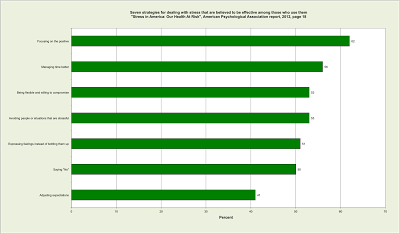Monday, February 18, 2013
Would you rather carry people up or bring them down?
Those two buttons on the wall between a pair of elevators are a reminder about attitude. When you write a speech or an article you can choose either to take people up or just to bring them down.
Recently I saw a Huffington blog post titled Money fear: 12 ways to fight financial stress written last September by Mary Pritchard, a psychology professor at Boise State University. Her post began by citing some statistics from an annual survey of 1226 adults done in August and September of 2011 by Harris Interactive for the American Psychological Association (APA), and titled Stress in America: Our Health At Risk. You can download that 78-page report it at the APA web site.
Mary’s first paragraph said:
“In the past couple of weeks, I’ve been blogging on how to cope with stress. Why? Because let’s face it, we are one stressed out bunch of people. The scary fact is that, in the American Psychological Association’s study “Stress in America,” the majority of American adults surveyed reported that their stress had increased during the past five years. And respondents fully realized that their stress levels were taking a toll on their health. In fact, 88 percent of women and 78 percent of men surveyed reported that their stress level had a strong or very strong impact on their physical health.”
Her first startling statement isn’t quite true, if by majority you mean more than half. The table shown above lists data that appear in a bar chart on page 16 of the APA report. In 2011 just 44% reported that that their stress had increased during the past five years. Only in 2008 was it a majority - 53%. How did the section of the APA report on The Impact of Stress open? It instead said:
“Reported stress levels for Americans overall are continuing to drop and have reached their lowest point since 2007, when the Stress in America survey first began tracking stress levels . While stress levels appear to be balancing out, they remain high and exceed what Americans consider to be healthy . Year after year, many Americans report extreme stress (22 percent in 2011; 24 percent in 2010 and 2009; 30 percent in 2008; and 32 percent in 2007) — an 8, 9 or 10 on a 10-point scale where 1 is little or no stress and 10 is a great deal of stress . These findings are indicative of a serious trend that could have long-term consequences on people’s health.”
A graph shows how the mean rating for stress (on a scale from 1 to 10) has dropped from 6.2 in 2007 to 5.2 in 2011. (Click on it to see a larger, clearer version).
Another graph show how the percent of Americans who reported extreme stress also dropped from 32% in 2007 (almost a third) to 22% in 2011 (less than a quarter). So, when you look at the results year by year you see a different and more positive picture of the changes than what people recall by looking back five years.
A bar chart shows ten significant sources of stress, which were: money (75%), work (70%), the economy (67%), relationships (58%), family responsibilities (57%), health problems affecting my family (53%), personal health concerns (53%), job stability (49%), housing costs (49%), and personal safety (32%).
Another bar chart shows the symptoms experienced in the last month as a result of stress, which were: irritability or anger (42%), feeling nervous or anxious (39%), fatigue (37%), feeling depressed or sad (37%), lack of interest, motivation, or energy (35%), headache (32%), feeling as if you could cry (30%), upset stomach or indigestion (24%), muscular tension (24%), change in appetite (17%), and change in sex drive (11%).
A third bar chart shows seven strategies for dealing with stress that were believed effective by those using them: focusing on the positive (62%), managing time better (56%), being flexible and willing to compromise (53%), avoiding people or situations that are stressful (53%), expressing feelings instead of bottling them up (51%), saying No (50%), and adjusting expectations (41%).
What about Mary’s second startling statement about how stress level had a strong or very strong impact on physical health? That was in a bullet point (and bar chart) in the section on Stress and Gender on page 23 of the report. But the very next bullet point said that men are more likely than women to report that their own stress has slight or no impact on their physical (36% vs. 26%) or mental health (40% vs. 32%).
Subscribe to:
Post Comments (Atom)







No comments:
Post a Comment